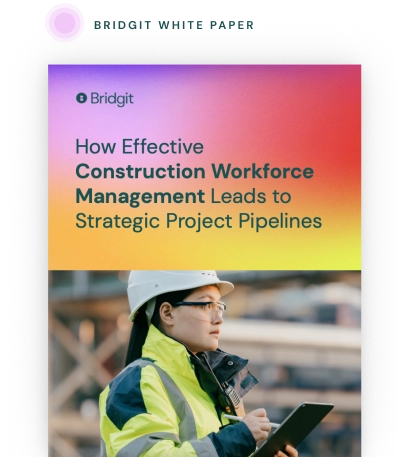Preconstruction is arguably the most important phase of the construction process, determining a project’s timeline and resulting profit margins. With so much weight placed on the proper execution of this phase and how much it can contribute to a project’s success (or failure), it’s crucial to get a handle on what it encompasses.
Table of Contents
So, what does preconstruction mean? Here’s what you need to know about what preconstruction is, what it involves, and its benefits.
What is preconstruction?
Preconstruction is the phase before construction in which preparatory planning is conducted, and a project is assessed in terms of feasibility. A strategic plan is developed during this phase that maps out how the construction project will be built.
In terms of a definitive preconstruction meaning, this phase is defined by these elements:
- First contact between owners and contractors
- Clarification about the project as a whole and its scope
- The acknowledgement of potential problems
- Timeline development and scheduling
- Cost and expense estimations
Why preconstruction is important
The preconstruction phase is crucial because it determines whether a construction project is feasible. Sometimes, the work that clients and prospective owners envision isn’t physically possible or would exceed expected costs.
During this phase, the client is informed on what’s needed to make the project a concrete possibility, whether that’s changing elements of the project or securing more funding. In other words, preconstruction helps clients decide whether to continue with the project with reasonable adjustments. The client gets a more realistic picture of the project before any actual work.
A more comprehensive project outline is developed for construction teams to follow.
What is determined during preconstruction?
Now that we’ve gone over the definition of preconstruction, you may wonder, “What are preconstruction services, and what do they encompass?”.
Scope of work
The first thing preconstruction services help determine is the project’s overall scope of work—i.e., what the construction project will consist of. In terms of the project’s scope, it’s best to investigate what the client wants to accomplish, with objectives clearly stated.
Budget
A budget should then be discussed. How much does the client have available to have the project completed? Given the time and resources needed to build the structure, is it realistic? It’s crucial to factor in design elements, which can significantly impact expenses.
At this stage, it makes sense also to devise a way to keep track of costs and come up with a way to cut back on expenses wherever possible without compromising quality.
The project’s designated team
Preconstruction meanings often focus on the activities and costs involved, but the project’s team is also decided during this phase. The selected team members designated to work on the construction project can be the difference between its eventual success or failure and will impact how it’s completed.
The project’s scope should help decide who will be put on a given project, as it will determine the number of people required to complete certain tasks.
You’ll likely need various skill sets on board (as construction projects often require). Establishing base design and construction teams should be the first priority. Afterward, you can think more about what subcontractors will be needed to accomplish project objectives.
Methods of communication and information exchange
This factor of preconstruction is often overlooked, but it’s arguably one of the most important in ensuring a project is properly executed. The large scale and complexity of construction projects mean sufficient communication is necessary. Effective communication makes it more likely that issues will be addressed in a timely manner and ensures that client expectations are met.
A communication plan should be created discussing what methods for information exchange will be used, with channels for correspondence specified.

Use your workforce data to create a competitive advantage
Download our white paper to see how effective workforce planning can help stay ahead of labor demands and create a strategic project pipeline.
What are the stages of preconstruction?
When considering the answer to the question “What is the preconstruction phase?”, it’s important to look at the various preconstruction stages. Here are the stages as follows.
Client consultation
Preconstruction first starts with client consultation. Contractors during this initial stage develop a greater understanding of what the client is looking for in terms of their project’s end result. Requests for Information (RFIs) are therefore issued, and relevant parties look over documents provided by owners.
In some cases, there may also be job site inspections, especially if an existing structure needs to be torn down or reworked.
Defining project scope
After a better idea of the project has been established, the project’s scope then needs to be defined. There may be cases where a client’s expectations must be reconfigured, as the project’s requirements may not align with what’s feasible.
During this phase, the contractor must work to get the project’s scope as close as possible to what the client wants while ensuring that it’s realistic and can be executed.
Cost estimation
In defining “What is preconstruction?” one of the most crucial aspects involves dealing with a project’s expenses. This stage involves estimating the project’s total cost to determine whether the project is financially viable and worth pursuing.
Cost estimation may be carried out by gathering quotes from suppliers, looking at historical data and information from previous similar projects, and taking into consideration the expected amount of profit earned from the project.
Problem assessment
A key factor in determining feasibility is assessing possible issues. This stage involves identifying challenges that may crop up before and during the project, whether due to practical issues or problems outside of anyone’s control (e.g., industry-wide labor shortages or economic conditions). Complications may be due to local or environmental regulations, for example.
These possible issues, solutions, and adjustments can be proposed to make a project fit a more achievable mold. Once an agreement has been reached, the project can then proceed.
Permit acquisition
The last stage of the preconstruction process involves the acquisition of any required permits to allow the project to begin. Oftentimes, though, this occurs in tandem with the other stages, as any delays in obtaining permits can result in setbacks that prevent the project from happening or force it to be stopped mid-way.
The benefits of preconstruction
Thinking about “What does preconstruction mean?” means considering the various benefits that the proper execution of preconstruction offers. Investing time and resources in ensuring that preconstruction is sufficiently carried out results in the following benefits:
- Getting a clearer vision of the project in terms of its end result and the process of delivery
- Locking in a timeline for the project and its expected date of completion
- Addressing client worries and clarifying factors that would previously be unknown
- The potential to save on expenses and increase profit margins by optimizing resources
Preconstruction is, in essence, the foundation of a construction project, as it sets expectations so issues can be anticipated and avoided beforehand.
Use Bridgit Bench to better manage your precon team
Now that we’ve answered the question, “What does preconstruction mean?” you might ask yourself, “What is the best way to carry out preconstruction?”. Many use technological solutions to assist with cost estimation, communication, and labor management.
For planning preconstruction people, Bridgit Bench is a tool worth considering.
Bridgit Bench is an all-in-one workforce management solution that allows you to oversee construction personnel and workers, including preconstruction teams, efficiently. With Bench, you can map out your precon teams more strategically and make more informed decisions to maintain a strong utilization rate across all teams while avoiding spreading anyone too thin.
Book a demo with Bridgit today!


